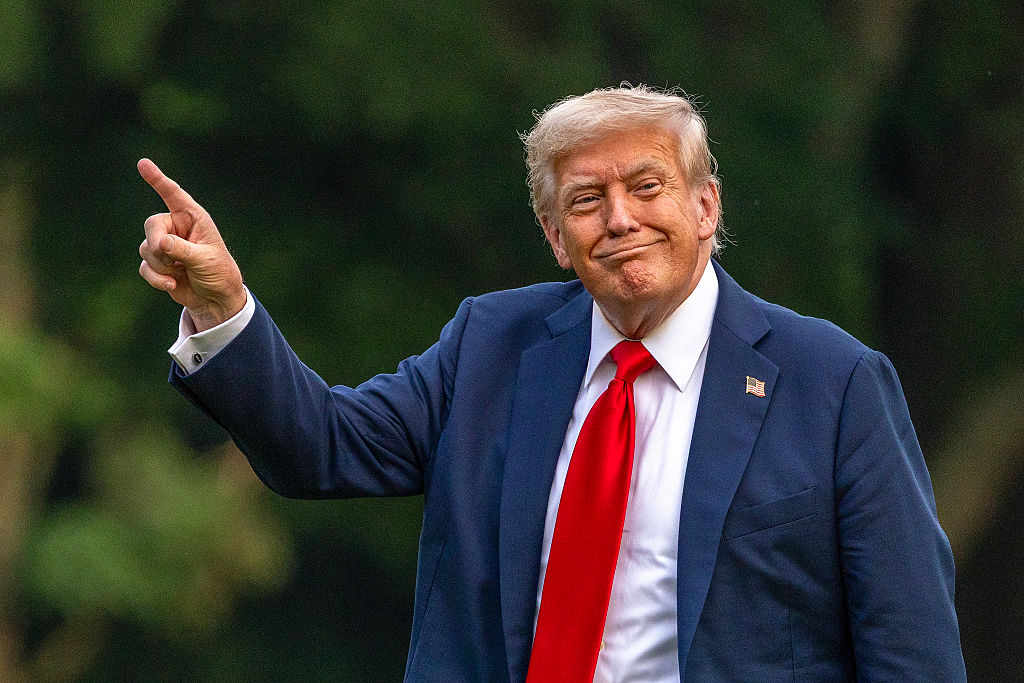5 Ways Portfolios Have Been Impacted In Trump's First Six Months in Office
President Trump's first six months in office have kept investors on their toes thanks to whipsaw tariff policies and a massive tax cut and spending bill.


Sunday, July 20, marked the six-month anniversary of President Donald Trump's second term in office.
Just as we saw in the first 100 days of Trump 2.0, the new administration continues to operate unlike any other we've seen in quite some time.
Several moves by the White House over the first six months have not only tested the patience of CEOs and global governments, but also investors, with portfolios going on a roller-coaster ride in 2025.
From just $107.88 $24.99 for Kiplinger Personal Finance
Become a smarter, better informed investor. Subscribe from just $107.88 $24.99, plus get up to 4 Special Issues

Sign up for Kiplinger’s Free Newsletters
Profit and prosper with the best of expert advice on investing, taxes, retirement, personal finance and more - straight to your e-mail.
Profit and prosper with the best of expert advice - straight to your e-mail.
While Trump's tariffs and trade policies unveiled over the past six months have been a major contributor to volatility in the markets, it is the passage of the "big beautiful bill" that stands out as the most significant accomplishment of the 47th president to date.
The bill has supporters and critics on both sides of the aisle. Time will tell who's right and who's wrong about this massive piece of legislation. It could take years to answer this question objectively.
In the meantime, investors are evaluating what Trump's first six months in office mean for their investment portfolios.
Here, we take a closer look at five ways our portfolios have been impacted during Trump's first six months in office – and what we can expect moving forward.
1. Tariffs impact corporate earnings
The Trump administration's on-again, off-again tariff policy has created significant uncertainty in the corporate world.
For one, it is difficult for companies to plan when they don't know where tariff rates will eventually land. Indeed, during first-quarter earnings season, many CEOs warned of a significant headwind from tariffs that will raise costs for the companies – and potentially prices for consumers on the products the companies sell.
Additionally, there's a concern that corporate earnings, which drive stock prices, will be impacted by the added cost of U.S. imports resulting from tariffs imposed here, as well as lower revenue abroad for American companies from reciprocal tariffs levied by countries with which we trade.
Goldman Sachs' analysis indicates that the effective U.S. tariff rate surged to 13% at the end of June from 3% at the beginning of January.
S&P 500 earnings for the second quarter measure the period from April through June and are reported between mid-July and late August. The LSEG estimate indicates a 5.9% increase in year-over-year EPS, while FactSet's most recent estimate of 5.6% would be the lowest quarterly growth since Q4 2023.
However, as Sam Stovall, chief investment strategist at CFRA Research, told CNBC, "With expectations so low in earnings, I think that the end result will end up being better than anticipated."
And this, he adds, "is encouraging for the market."
Related: Six Key Earnings Terms Every Investor Should Know
2. Debt concerns rise after the passage of Trump's "big, beautiful bill"
Elon Musk is not a fan of the "big, beautiful bill" and his opinion of President Trump has declined in recent months as a result of the massive legislation. So much so that he's forming the America Party to protest the size of the U.S. national debt and deficit.
"The Republican Party has a clean sweep of the executive, legislative and judicial branches and STILL had the nerve to massively increase the size of government, expanding the national debt by a record FIVE TRILLION DOLLARS," Musk posted on X on July 6.
While investors appear to be ignoring the warning signs of a federal government whose spending and borrowing are out of control, there is plenty of opposition from folks who recognize the long-term damage high-spending bills could do to the U.S., and by extension, the markets.
"The legislative package passed by Congress this week will be the most expensive reconciliation bill in a quarter of a century and will add trillions of dollars to the U.S. debt over the next 10 years," wrote the non-partisan Peter G. Peterson Foundation on July 3.
According to the Congressional Budget Office (CBO), the net interest costs on the national debt are expected to be approximately $1 trillion in 2025, rising to $2.2 trillion in 2034.
By this point, the annual interest costs on the national debt will exceed the annual budgets of both Medicare and the Department of Defense.
That might not affect your portfolio in the near term, but it could over the long term in the form of higher interest rates and increased volatility.
Related: The Dollar Index Is Sliding. Is Your Portfolio Prepared?
3. Recession fears ease, but an economic slowdown is still a possibility
In early April, when the tariff situation was causing great concern among American companies and consumers alike, Goldman Sachs raised the odds of a U.S. recession twice in one week, from 20% to 45%, on fears of an ongoing trade war.
However, President Trump's pullback from the aggressive retaliatory tariffs announced on "Liberation Day," as well as deals made with several countries, have since lowered the odds of a recession down to 20%, according to prediction platform Polymarket.
And while the stock market has rallied back to record highs in the past three months, an economic slowdown could still be in the cards – and put equities' rebound at risk.
"The big takeaway from these recent trade headlines is that the path to greater certainty on trade policy is likely to be uneven," says Glenmede's Chief of Investment Strategy & Research Jason Pride and Vice President of Investment Strategy Michael Reynolds.
The two add that "investors seeking to better understand where trade policy may be going should not underestimate the administration's resolve to seek more balanced trade and perhaps endure near-term economic pain to get there."
Related: Kiplinger GDP Outlook
4. Tech regains dominance, but uncertainty lingers
Earlier this year, tech stocks were pounded as investors rotated out of the Magnificent Seven and other leading companies in the sector, opting for investments with less volatility.
Part of the reason for the rotation out of tech is concern about slowing artificial intelligence (AI) spending, particularly following the January release of DeepSeek, a lower-cost AI model from China.
Between late February and early April, the S&P 500 Information Technology Sector Index lost 26%. However, it has since recovered all of those losses and then some to trade at record highs.
Unfortunately, the tech gains generated over the past three months could be eroded if tariffs and trade uncertainty persist for an extended period.
"It's been two steps forward, one step back," Deepwater Asset Management Managing Partner Gene Munster told Yahoo Finance in early July.
Munster notes that while we're still moving forward, the Trump administration's recent pushback of the tariff deadline to August 1 "opens up this unknown [for Big Tech] about what happens now" and later this year, because any changes probably won't really start to take effect until midway through the September quarter.
A genuine concern for many tech companies – including AI chipmaker Nvidia (NVDA), which has an outsized weighting in widely owned S&P 500 ETFs – is the tariffs that Trump may apply to imported semiconductors.
While U.S. semiconductor plants are under construction, a majority of these chips are still imported, which affects both their cost and the subsequent retail prices of smartphones and other high-demand electronics.
But the Trump administration's recent headway with China – and a slight relaxing of restrictions on some chip sales – provides a silver lining for tech companies and tech investors.
Related: The Best Tech Stocks to Buy
5. Global stocks turn in a rare outperformance
U.S. markets underperformed their global counterparts during Trump's first 100 days in office. They continue to do so.
On a total return basis (price change plus dividends), the Vanguard FTSE All-World ex-US ETF (VEU) is up more than 18% for the year to date through July 18, more than double the 7.4% gain for the Vanguard Total Stock Market ETF (VTI).
"Coordinated policy support for Ukraine and moderate fiscal expansion focused on infrastructure, innovation and health care are increasing Europe's credibility as a geopolitical and economic counterweight to the United States," says Andrew Lake, chief investment officer at Mirabaud AM.
It has been a long time since U.S. stocks have trailed their global counterparts. While you might feel you've missed the boat, global stocks experience periods of outperformance and underperformance that carry on for some time.
"Over time, international stocks have gone through multiyear periods when they either outperform or underperform the United States, partly because of differences in economic growth, currency trends, and valuation shifts," says Morningstar portfolio strategist Amy Arnott.
For example, between 2002 and 2007, international stocks outperformed U.S. stocks, with excess returns of up to 10 percentage points in May 2007. This could be the start of another five-year run.
As long as the Trump administration continues its stop-and-start approach to trade, investors should consider including global stocks in their portfolios.
Related: The Best European Stocks to Buy
Related content
- How the Stock Market Performed in the First 6 Months of Trump's Second Term
- Can Trump Fire Powell?
- What Trump Has Done With Social Security So Far
- Stocks to Buy for a Trump Presidency
Profit and prosper with the best of Kiplinger's advice on investing, taxes, retirement, personal finance and much more. Delivered daily. Enter your email in the box and click Sign Me Up.

With over a decade of experience writing about the stock market, Karee Venema is the senior investing editor at Kiplinger.com. She joined the publication in April 2021 after 10 years of working as an investing writer and columnist at a local investment research firm. In her previous role, Karee focused primarily on options trading, as well as technical, fundamental and sentiment analysis.
-
 Stocks Struggle for Gains to Start 2026: Stock Market Today
Stocks Struggle for Gains to Start 2026: Stock Market TodayIt's not quite the end of the world as we know it, but Warren Buffett is no longer the CEO of Berkshire Hathaway.
-
 Tip: Ways to Track Your Credit Card Rewards
Tip: Ways to Track Your Credit Card RewardsHere are the best strategies and apps to help you stay current with your credit card rewards.
-
 How New Investors Can Pick Their Perfect Portfolio, According to a Pro
How New Investors Can Pick Their Perfect Portfolio, According to a ProSee what Cullen Roche has to say about finding your perfect portfolio as a new investor and his two-word answer on where he thinks the stock market is headed in 2026.
-
 Stocks Struggle for Gains to Start 2026: Stock Market Today
Stocks Struggle for Gains to Start 2026: Stock Market TodayIt's not quite the end of the world as we know it, but Warren Buffett is no longer the CEO of Berkshire Hathaway.
-
 How New Investors Can Pick Their Perfect Portfolio, According to a Pro
How New Investors Can Pick Their Perfect Portfolio, According to a ProSee what Cullen Roche has to say about finding your perfect portfolio as a new investor and his two-word answer on where he thinks the stock market is headed in 2026.
-
 High-Net-Worth Retirees: Don't Overlook These Benefits of Social Security
High-Net-Worth Retirees: Don't Overlook These Benefits of Social SecurityWealthy retirees often overlook Social Security. But timed properly, it can drive tax efficiency, keep Medicare costs in check and strengthen your legacy.
-
 Do You Have an Insurance Coverage Gap for Your Valuables? You May Be Surprised to Learn You Do
Do You Have an Insurance Coverage Gap for Your Valuables? You May Be Surprised to Learn You DoStandard homeowners insurance usually has strict limits on high-value items, so you should formally "schedule" these valuable possessions with your insurer.
-
 If You'd Put $1,000 Into Lowe's Stock 20 Years Ago, Here's What You'd Have Today
If You'd Put $1,000 Into Lowe's Stock 20 Years Ago, Here's What You'd Have TodayLowe's stock has delivered disappointing returns recently, but it's been a great holding for truly patient investors.
-
 Don't Trade After-Hours Without Reading This
Don't Trade After-Hours Without Reading ThisAre you a night owl or an early bird with a yen for active trading? Before you transact after-hours, consider these tips and potential traps.
-
 8 Practical Ways to Declutter Your Life in 2026: A Retirement 'Non-Resolution' Checklist
8 Practical Ways to Declutter Your Life in 2026: A Retirement 'Non-Resolution' ChecklistHere's how to stop wasting your energy on things that don't enhance your new chapter and focus on the things that do.
-
 To Retire Rich, Stop Chasing Huge Returns and Do This Instead, Courtesy of a Financial Planner
To Retire Rich, Stop Chasing Huge Returns and Do This Instead, Courtesy of a Financial PlannerSaving a large percentage of your income, minimizing taxes and keeping spending in check can offer a more realistic path to retiring rich.